The follicular unit extraction (FUE) hair transplant process varies in performance from one patient to another and also depends on the surgeon’s skill and technology at their disposal. A classification or grading system is made necessary by the wide variation that exists in the donor zones of hair transplant patients which are largely attributed to the skin and hair variety that exists in humans. In a publication in the clinical cosmetic and investigational dermatology journal, Dr. Umar and co-workers described a new FUE classification system. According to Dr. Umar, who is of the Department of Medicine, University of California, Los Angeles, and Dr. U Hair and Skin Clinic, Manhattan Beach, California, “the notion that having curly hair always results in a complicated FUE surgery or failure is not true”; In fact, FUE is easy to perform in many curly-haired patients. Conversely, some straight-to-wavy-haired individuals also present FUE challenges requiring specialized tools and skills to lessen the likelihood of surgery failure.”
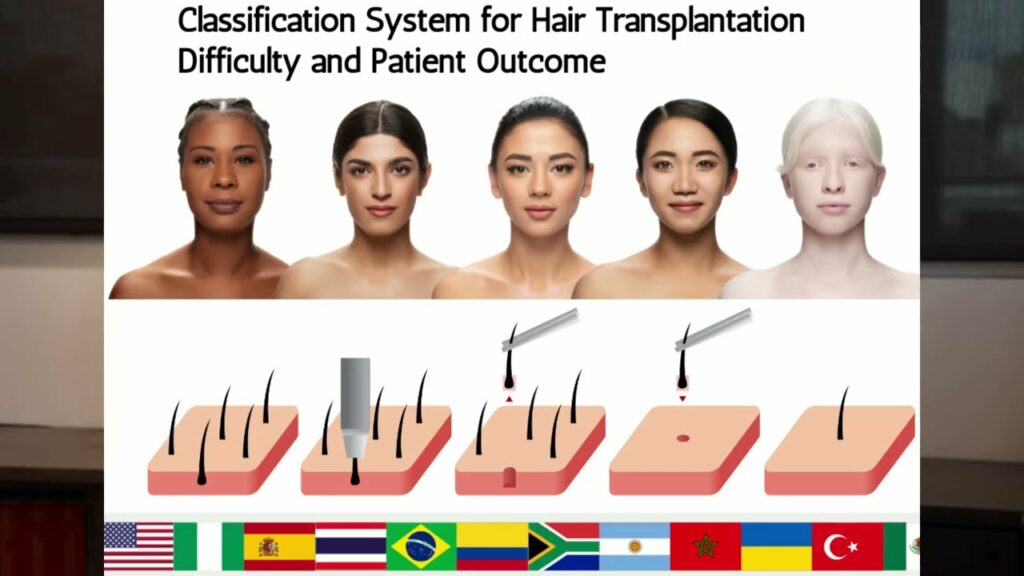
VIDEO: New FUE Classification System Explained. Know Your Hair Transplant Donor Type To Predict FUE Outcome
New FUE Classification System Explained. Know Your Hair Transplant Donor Type To Predict FUE Outcome
Dr. Sanusi Umar AKA Dr. U talks about his findings regarding FUE challenges. He discusses the myth of curly hair FUE being the most difficult and talks about the real factors that make an FUE operation more or less challenging.
Dr. Umar states that the different combinations of hair and skin traits lead to unique follicular shapes and adhesive properties. This is further complicated by the human species continuously migrating for thousands of years and mixing their genes.
“Even societies presently perceived as “homogeneous” result from the aggregation of several previously disparate phenotypic traits. A reliable follicular unit extraction – FUE classification or scoring system must account for this”.
The Sanusi FUE Score Scale (SFS Scale)
Hair transplantation is a delicate process. The new classification system developed by Dr. Umar (SFS Scale) provides a unique approach to evaluating the challenges of this procedure. Many surgeons have traditionally relied on racial stereotypes and geographic location to determine hair transplantation challenges. The SFS FUE classification system, on the other hand, uses “points.” These points are determined by the specific patient’s hair (straight, wavy, or curly/coiled) and skin types (medium, thin, or thick). The point total comprises the SFS score, grading the patient’s overall challenges to FUE hair transplantation. This system was agreed upon by 13 FUE practitioners from all over the world. This system allows for a more objective assessment of each patient.
What Are the Key Factors Responsible for FUE Procedure Difficulty?
The scoring system assigns scores using two major parameters, which the FUE practitioner assesses using visual and tactile cues. These are
- Hair type: hair the shape of the hair is used
- Skin viscoelastic properties with thickness and firmness as proxies
HAIR FACTOR: Hair Type Parameter for FUE Donor Area Grading
The SFS hair parameters recognize 3 broad hair types relevant to FUE dynamics. It combines types 1 and 2 hair of the widely used Andre Walker hair chart into one hair category called Straight and wavy because both hair types respond similarly to FUE. The remaining two hair categories (Curly and Coily) correspond to types 3 and 4 of Andre Walker’s hair charting system.
- Straight and wavy: corresponds to types 1 & 2 of Andre Walker’s Hair chart
- Curly: corresponds to type 3 of Andre Walker’s Hair chart
- Coily-Kinky: corresponds to type 4 of Andre Walker’s Hair chart
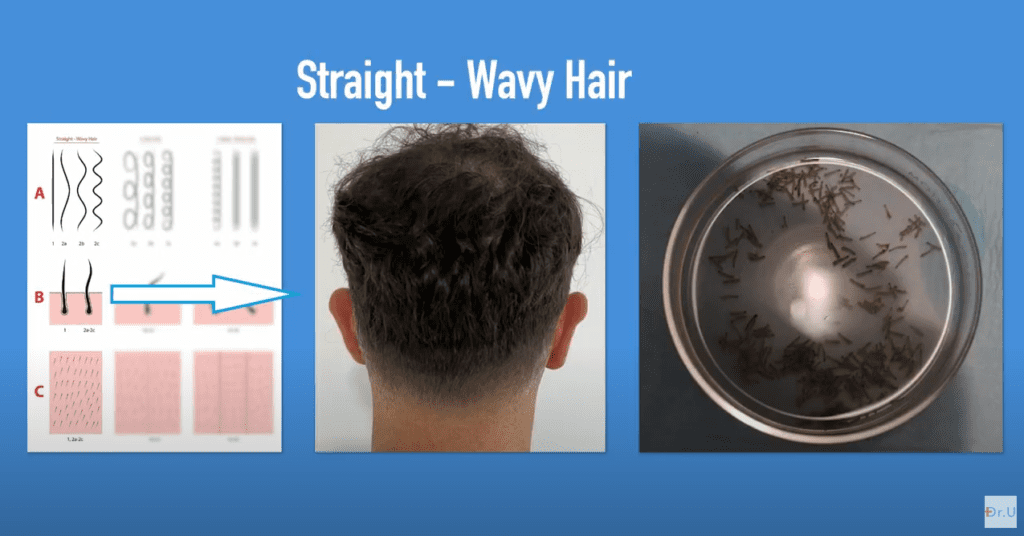
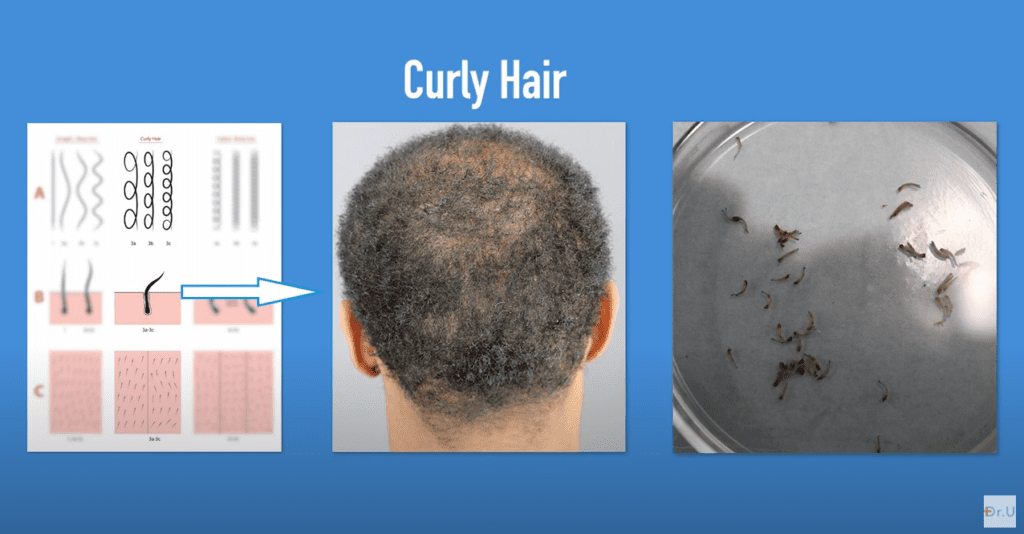
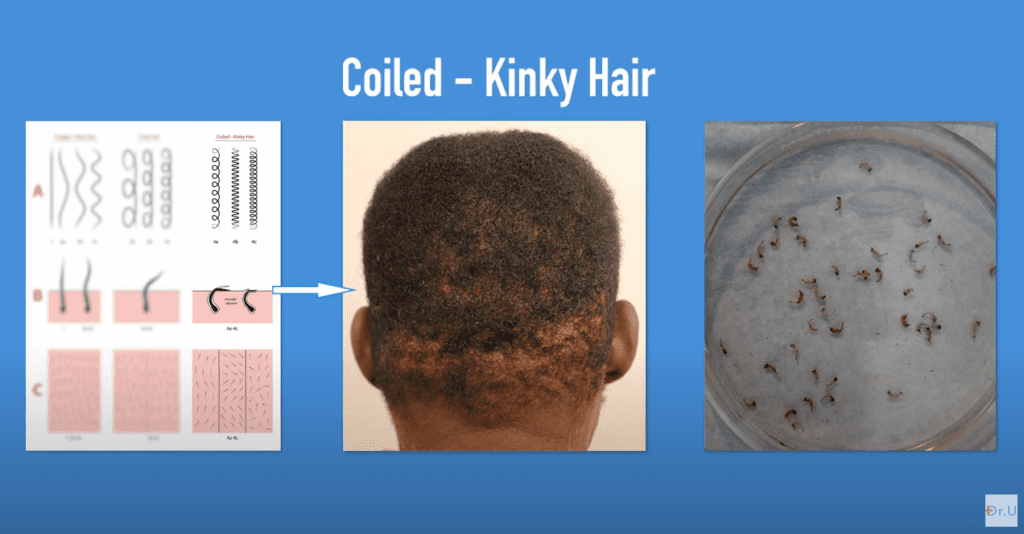
SKIN FACTOR: Skin Parameter for FUE Donor Area Grading
The Factors that Contribute to FUE Procedure Difficulty
The SFS skin typing recognizes 3 broad groups based on relative thickness and firmness caused by the epidermis and dermis, which are the key skin components responsible for FUE difficulty: Thickness and firmness go together
- Thick/Firm Skin
- Soft/Thin Skin
- Medium Skin
Using visual and tactile cues developed by Dr. Umar and his co-workers, the practitioner categorizes the FUE donor area as belonging to one of the above 3 broad skin groups. The visual and tactile cues are as follows:
Thick/firm Skin Type
This skin type would exhibit one or more of the following properties:
- Hair bunching/bouquet hair.
- Pitting or hooding of the hair exit points.
- Turgid, hard to pinch.
- Peau d’orange appearance.
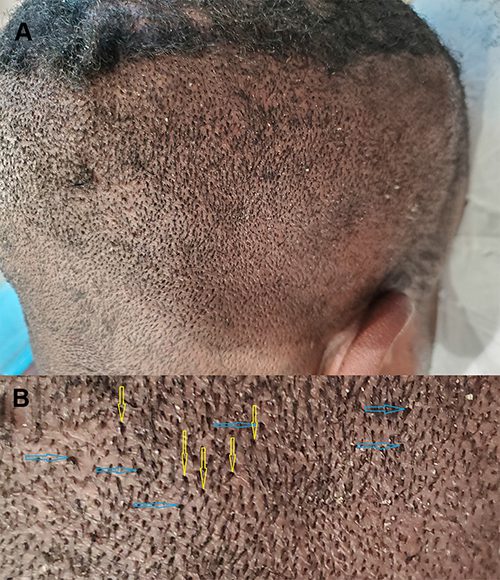
- Slippery Surface (Tendency of punch to slip or bounce off the scalp skin surface).
- Acne keloidalis nuchae.
- Resistance to punch penetration.
- Resistance to penetration of a hypodermic needle (27 gauge or less), e.g., during local anesthesia injection.
Soft/Thin Skin Type
This skin type (Figure 4) does not meet any of the criteria above for thick/firm skin and exhibits two or more of the following properties:
- Punch penetration is easy with little to no resistance and a tendency to tear the top layer.
- Tendency for decapping.
- Very lax, folds easily when pinched.
- Very thin/fine hair caliber ± high hair density.
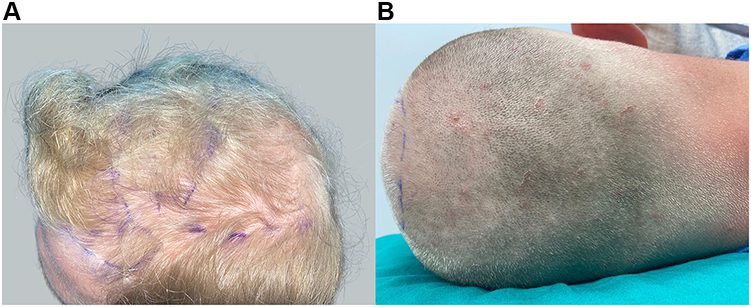
Medium thickness/firmness Skin Type
This skin type (Figure 5) does not meet any of the criteria above for thick/firm or soft/thin skin types and exhibits two or more of the following properties:
- Average pinch response.
- Average punch penetration.
This skin type accounts for the majority of FUE cases:
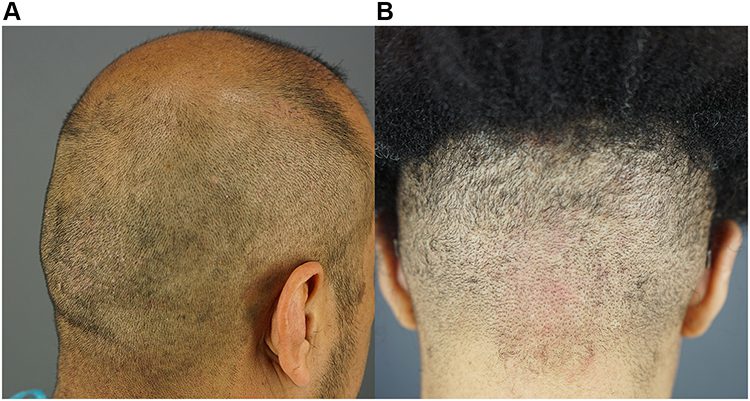
How To Use the Universal FUE Scoring Scale
The universal classification system is a two-tiered process. Done in these two steps:
- The practitioner determines the total SFS Points of hair and skin
- Using the total SFS points, the practitioner determines the final SFS Class or Grade
What is The Universal FUE Classification System? Know Your Hair Transplant Donor Score
No Description
STEP 1: Determine SFS Points:
Using the table below (table 1), the skin type earns SFS points (x) which is either 6 (thick/firm skin) or 4 (soft/thin skin), or 1 (medium skin). The hair type earns SFS points (y) which is either 1 (straight-wavy hair), 2 (curly hair), or 3 (coily/kinky hair). Tally SFS points (x + y) to determine the total SFS Score.

STEP 2: Determine SFS Class or Grade:
Using the total SFS score (x+y) from table 1, which would be a number between 2 and 9, go to table 2 to assign the final SFS Grade or Class.
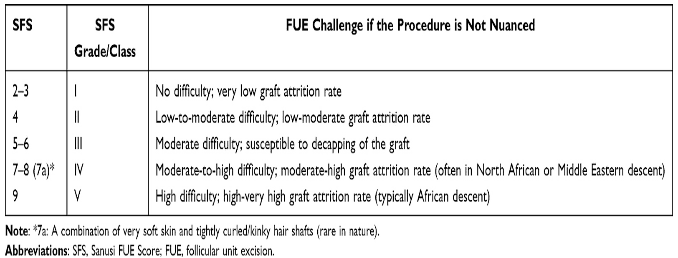
As shown in the table above, an SFS Scale score of 4 (SFS Class II), which is a combination of coiled-kinky hair and medium-thick/firm skin, indicates a low-to-moderate FUE difficulty. An SFS Scale score of 5 or 6 (SFS Class III) combines straight/wavy or gently curled hair with soft/thin skin and presents a moderate challenge to FUE. An SFS Scale score of 7 or 8 (SFS Class IV) combines straight/wavy or gently curled hair with a thick/firm scalp skin and suggests moderate-to-high FUE difficulty. Lastly, an SFS Scale score of 9 (SFS Class V) represents coiled-kinky hair and a thick/firm scalp and presents the biggest FUE challenge. The practitioner must have specialized FUE equipment or possess extraordinary FUE skills to perform the procedure successfully.
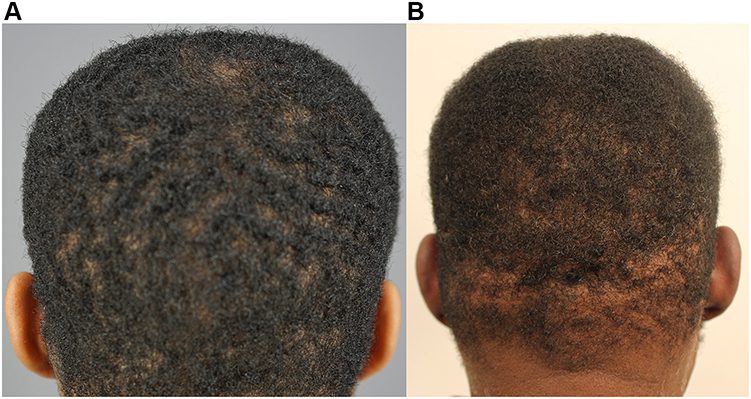
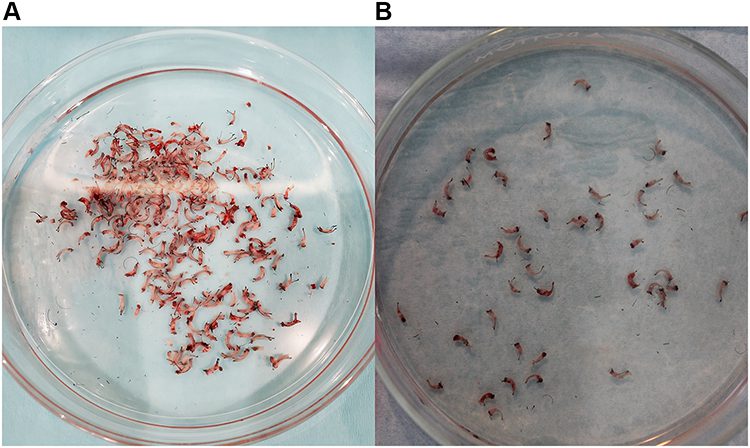
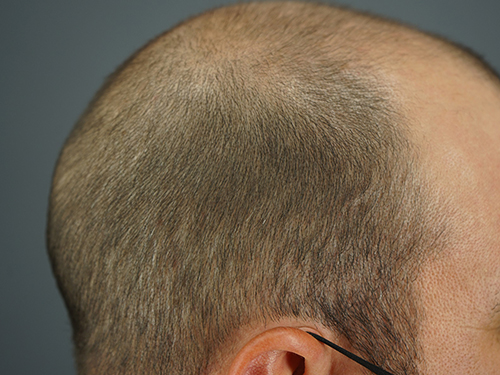
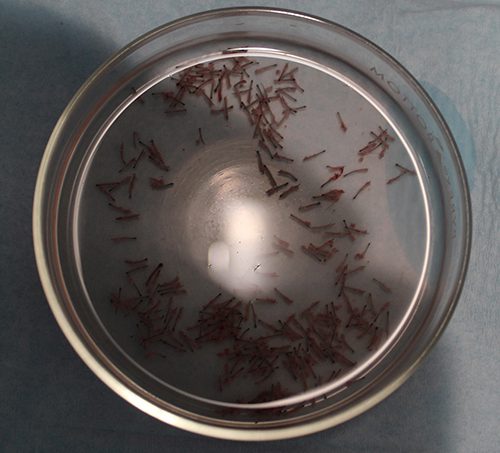
It’s a Combination of Factors, Not Isolated Traits
Ultimately, the results of the study on the SFS classification point out that FUE hair transplantation challenges are determined by the combined effect of the patient’s hair type and skin characteristics, including thickness, firmness or turgidity, pattern, and slipperiness. This suggests that hair transplantation is not always challenging for all patients of African descent or those with curly hair, as previously assumed. Instead, hair transplant challenges are a lot more nuanced and not confined to racial, ethnic, or geographic stereotypes.
Dr. Umar and co-workers went on in the paper to provide a vivid example of the error of using ethnic/racial/geographic stereotypes in determining FUE difficulty. The example was a patient of African descent with a medium skin type but coily hair. This led to a total SFS score of 4, which makes her class 4, connoting only a low-moderate FUE difficulty, meaning the practitioner can expect a relatively straightforward procedure. If racial/ethnic stereotypes had been used, she would have been assumed to be a difficult FUE case and possibly denied the procedure without an objective justification.
On the other hand, another patient of Afro decent in the publication had kinky hair (SFS point 3) and thick/firm skin (SFS point 6), giving him a total SFS score of 9, which effectively makes him a Class V connoting the greatest FUE difficulty. So here, although both patients are of African descent, they are predicted objectively to present very different FUE challenges to the practitioner.
Equally Relevant to Both FUE Doctors and Patients
Why Should FUE Surgeons Care:
No FUE practitioner wants to start a hair transplant procedure only to realize halfway through that they can’t successfully complete the operation. As a doctor, you want to provide the most optimal results for your patients. Grafting an area only to realize a couple of months down the road that there will be no hair growth due to transected grafts is a pain for both parties involved.
FUE practitioners should start evaluating their patients with the SFS classification system before accepting patients and starting any transplant surgeries; it would allow them to avoid taking on patients they don’t have the equipment to help out with an FUE hair transplant surgery successfully. A failed attempt of an FUE means the patient will have to go for unplanned repeat surgery, and they’re not going to be happy about that. Unsatisfied patients mean backlash and bitter reviews, and thus, a negative experience for everyone involved.
Why Should FUE Patients Care:
An FUE hair transplant surgery is not cheap, and the more coverage you need, the higher the surgery cost goes parallel to the number of grafts. One of the reasons individuals suffering from hair loss opt for an FUE transplant is because they want it to be a one-time cost and save them money over the course of years compared to temporary solutions.
Having an FUE procedure that turns out to be unsuccessful and doesn’t give the results the patient hoped for means they would have to go through the same process again, and, consequently, pay for surgery again.
To avoid this problem, you should do extensive research as a patient. Does the practitioner you’re considering have the equipment and skillset to handle your SFS class? Do they have a record of successfully performing FUE hair transplant surgeries on patients with a skin and hair type similar to yours? You’re not sure? This is where you ask questions. You are about to invest in a procedure that could either be life-changing or become just another failed attempt in solving the issue of your hair loss. Interview your doctor! Ask them if they know of and use the SFS classification method to evaluate their patients. What’s their average attrition rate in surgeries on patients with physical attributes like yours? Don’t hesitate to ask any and all relevant questions to your doctor – you’ll be doing both of you a favor!
Why is This Groundbreaking In the Industry?
The Myth of Curly Hair
The notion that Afro-textured hair is the single most important factor in terms of FUE hair transplant difficulty resulted in a high rate of denial to patients of African descent suffering from thinning hair and baldness. Furthermore, the “curl means difficult” created a boogeyman that can be blamed for all poor results in the affected population no matter the actual reason. The traditional micro-punch used in the classic FUE process is tailored to straight-wavy hair follicles. This means that unknowingly, FUE transplants for patients with Afro hair types are set up to be difficult or fail.
When we finally allow ourselves to think outside the tiny box, we see that it’s not the curly-coily hair type that’s an issue. It’s the technology that we’ve been using without ever questioning it. Way more than a hair type, what really presents a challenge in the process of FUE is the combination of an incomplete understanding of all the factors that play into hair graft harvesting and the lack of technology designed to assist all patients. By looking at the challenges of FUE from this perspective, it becomes obvious that instead of turning down patients, we could learn how to categorize patients more efficiently, and also design a punch that is not restricted to a specific dermal depth that’s clearly not working for everyone.
Intermarriages, Gene Flow, and FUE Hair Transplants
It’s undeniable that race correlates with certain structure types in the stratum corneum of the epidermis, and that plays a factor in how easy or challenging an FUE operation could be. Dr. Umar and his colleagues are not arguing that. In fact, the results of their studies are consistent with that. In their analysis of the grafts taken from a patient of African descent who had undergone FUE, they described the stratum corneum in the area with a higher transection rate as more compacted than that of another area with less transection rate. Transection rates were registered in the same patient’s scalp by the same practitioner using the same instrumentation. This study, among other similar studies, supports the idea that race plays a factor in the stratum corneum structure.
However, due to migration, intermarriages, and gene admixing, isolated traits do not follow these stereotypes consistently. Instead, they combine in an individual in a manner that reflects the migratory history and gene mixing odyssey of their ancestors over thousands of years. According to Dr. Umar, there was a within-Africa migration long before there was an out-of-Africa migration. The human specie is never static and has never confined its need to spread its genes to the familiar. We now have evidence that homo sapiens even mixed with species such as Neanderthals, Denisovans, etc.! There are many moving elements when it comes to hair transplants, and it’s time we started considering those. Relying simply on geographics and the patient’s apparent race is not sufficient anymore for determining the FUE difficulty level. Frankly, it never was. It’s time to revolutionize FUE hair transplant practices and adopt more inclusive practices for patients.
Frequently Asked Questions
What if the doctor I went to doesn’t know how to classify me for FUE? Should I seek another doctor?
You don’t have to resort to finding a different FUE practitioner immediately. If you have straight or wavy hair and a skin type of medium thickness and firmness, your doctor will most likely be able to operate on you successfully. Otherwise, ask your doctor about their curly hair and thick or soft scalp FUE record and how comfortable and confident they are in taking you on as a patient. If your doctor does not have a solid record of successfully performing surgeries for your hair and skin type, that’s when it may be a good idea to seek a different surgeon.
Does having very little hair on my head make me a bad FUE candidate?
If you go to an FUE surgeon who is equipped to perform a body hair transplant (BHT), not having a lot of donor hair on your head won’t make you a bad FUE candidate. Your doctor should be able to excise hair follicles from other areas of your body and provide sufficient coverage for your thinning areas.
I’ve had several failed and botched hair transplant surgeries. Is there still hope that I can get it fixed and how can I know that the next surgeon will do a better job?
There’s almost always a chance to fix botched hair transplant surgeries if you go to a qualified doctor. To ensure your next surgery is not yet another in the series of failed surgeries, follow these steps:
- Ask the doctors you’re considering if they use the SFS classification system to evaluate their potential patients.
- If you’ve had multiple failed surgeries, chances are you don’t have enough donor hairs on your head. Ask if the doctor performs BHT and what their average BHT graft survival rate is.
- Inquire about their record of fixing botched surgeries and ask to see as many before and after photos as they’re able to provide.
- Look up their reviews on as many platforms as you can.
References
- Mohmand M, Ahmad M. Transection rate at different areas of scalp during follicular unit extraction/excision (FUE).
- Richards GM, Oresajo CO, Halder RM. Structure and function of ethnic skin and hair. Dermatol Clin. 2003;21(4):595-600. doi:10.1016/s0733-8635(03)00081-0
- Rogers NE, Callender VD. Advances and challenges in hair restoration of curly Afrocentric hair. Dermatol Clin. 2014;32(2):163-171. doi:10.1016/j.det.2013.12.004
- Umar S. Comparative Study of a Novel Tool for Follicular Unit Extraction for Individuals with Afro-textured Hair. Plast Reconstr Surg Glob Open. 2016;4(9):e1069. Published 2016 Sep 27. doi:10.1097/GOX.0000000000001069
- Umar S, Shitabata P, Rose P et al. A New Universal Follicular Unit Excision Classification System for Hair Transplantation Difficulty and Patient Outcome.

